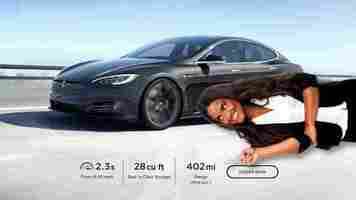Here’s why you should take EPA range estimates for EVs with a pinch of salt
Like a well-known rugby shirt wearing, floppy haired car critic, when I hear about new cars, I get “the fizz.” I dive straight into the stats, the graphic renders, and head to forums to find out what others are saying about the new whip.

When it comes to EVs, the first stat I look for is the Environmental Protection Agency’s (EPA) estimated range figure. In a world of electric vehicle Top Trumps, this is the number that beats all else. Forget naught to 60 times, it’s all about how far an EV can go on a single charge.
Except, it’s painfully clear that EPA figures can’t really be trusted. Just like emissions tests in combustion engine cars , what we get in the real-world is proving to be quite different from what dyno-based tests suggest.
The latest tests from Edmunds, a US-based car buying advice website, are a perfect example. You can read their full report here , but here’s the one thing you need to know: in real-world tests electric cars virtually never achieve their EPA estimated range.
Before you go thinking that Edmunds is some harbinger of range anxiety — a necromancer of negativity — it’s important to know that while some EVs fell way short of their EPA range estimates, others far surpassed them.
Here are a few examples:
1. The Porsche Taycan 4S: 203 miles (EPA range) v 323 miles (Edmunds’ tests) That’s over 59% further.
2. A 2019 Hyundai Kona Electric: 258 miles (EPA) v 315 miles (Edmunds’ tests).
3. Even the MINI Cooper SE: 110 miles (EPA) v 150 miles (Edmunds’ tests).
Not every car test faired this well. In fact, one brand in particular continually fell short of estimated ranges: Tesla.
For example, a Long Range Model X missed its expected range by 10%, a Model 3 Performance fell 17% short of its EPA range, and a Model Y performance stopped nearly 10% short of its suggested EPA range.
So what’s going on?
There are a few things that could affect the numbers Edmunds are returning. Even though the company has a set protocol, it’s impossible to drive every single EV tested in exactly the same way, under exactly the same conditions.
As Edmunds shows, there was a 12 degree difference in ambient temperatures when testing. One persons’ real-world tests won’t translate to everyone else.
What’s more, Edmunds’ tests place a greater emphasis on city driving than the EPA protocols do, with regenerative braking this can lead to higher ranges due to the stop/start nature of town and city driving.
It’s possible that Edmunds’ testing protocol simply didn’t suit the Teslas they were driving. But there are other things, specific to Tesla, to consider.
Another reason why Tesla falls short is because of how it adjusts its EPA estimates to get the biggest number possible, most likely for marketing reasons.
As this article from Car and Driver explains , the range figure the EPA comes up with isn’t as simple as just testing the car on a dyno and seeing how long it can last.
EPA tests also let manufacturers apply a voluntary range reduction, it also applies an adjustment factor which can vary from vehicle to vehicle, and brand to brand. There are also ways to game the system which are too complex to mention here, head over to Car and Driver for more on those.
The crux of the matter, though, is that Tesla has been in the game longer than most, and it knows how to get the absolute most out of its vehicles for EPA tests. So much so, its EPA range figures often far exceed what drivers get in the real world.
So if we can learn anything from all of this, it’s to take EPA range estimates with a handy helping of salt. Depending on what EV you buy, how you drive it, and in what conditions its driven, you might get more or less range than the EPA quotes. Consider EPA figures a ballpark concept at best.
SHIFT is brought to you by Polestar. It’s time to accelerate the shift to sustainable mobility. That is why Polestar combines electric driving with cutting-edge design and thrilling performance. Find out how .
Would you buy a car without its promised tech? BMW latest to make compromises due to chip shortage
This week BMW confirmed with Auto-blog that it’s shipping vehicles without touchscreen functionality in response to the semiconductor chip shortage.

The issue was initially raised on a Bimmerfest forum post stating that customers who receive a touchscreen free car receive a $500 credit.
The post says these cars will also lose the BMW Backup Assistant if they were marketed with the optional Parking Assistant Package. The Backup Assistant enables automatic reversing in narrow parking areas and those with poor visibility.
Buyers receive $500 compensation for the lowered functionalities… but is that enough compensation?
Reduced functionalities have been a trend this year
It’s not the first time cars will go to market with reduced functions in response to the chip shortage. In March, General Motors announced it was building 2021 Silverado and Sierra pickups without active fuel management modules .
In May, Tesla removed the passenger-side lumbar support for the Model Y, which Elon Musk attributed to materials shortages.
In June, General Motors announced that it would start building vehicles without the Automatic Stop/Start feature. This feature turns off the engine when a driver stops at an intersection and automatically restarts it when the driver steps on the throttle.
The automaker told Carom :
The chip shortage has a flow-on effect
I wrote about the semiconductor chip shortage a couple of months back, interviewing a bunch of industry representatives and analysts.
The verdict for car buyers wasn’t great, with stories of cars sitting in factories ready for rollout… except for their computers and processors. The general consensus was to prepare to pay more and wait longer for the cars you want.


This has unfortunately borne fruit. Cars are either extremely hard to buy or higher in price. Carmakers are allocating their chips to the most profitable cars and SUVs, making lower-priced cars less accessible.
Thomas King, president of the data and analytics division at J.D. Power believes that the lack of inventory is causing record transaction prices and profit for each car sold. October showed a record high of $43,999, the fifth consecutive month above $40,000. This is 19.3% higher than in October 2020 when prices hit $36,887.
But it’s a great time to sell your car
The big winner is anyone selling a used car. J.D. Power found that the average trade-in value is trending towards $8,738, an increase of $3,598 (70.0%) from a year ago — massive.
But challenges await for both automakers and buyers. Automakers have been investing big bucks and ambitious timelines for creating new electric and autonomous vehicles. These require a lot of chips. Automakers use about 10% of the chips on the semiconductor market. A modern electric vehicle can use up to 3,000 chips . Oof.
The shortage will stall production. It also leaves a mass of impatient consumers waiting for their orders. Are they prepared to opt for cars with reduced tech? Or will they cancel their orders altogether?
The chip shortage will remain significant until at least Q2 2022. This is also a significant blow for innovation. We can expect a much longer wait for future tech like expanded autonomous functionalities.
But it’s also a downer for the plethora of companies building and supplying the tech, especially the startups, who may lack the scale and relationships to get their orders prioritized. This is going to hurt for a while yet.
Amsterdam trials electric ‘trash boats’ to clean up its streets
This article was originally published by Sarah Wray on Cities Today , the leading news platform on urban mobility and innovation, reaching an international audience of city leaders. For the latest updates follow Cities Today on Twitter , Facebook , LinkedIn , Instagram , and YouTube , or sign up for Cities Today News.

Amsterdam is piloting electric waste collection boats to cut the number of rubbish trucks in the congested city center and limit the damage from heavy vehicles to weakened bridges and canal walls.
The six-month trial will run in parts of the Red Light District (de Wallen) and the Nieuwmarkt area.
Residents in these neighborhoods will put their household waste bags out on the street as normal on Mondays and Thursdays. The boats, operated by municipal water company Waternet, will be moored in the canals on collection days and waste collectors will throw the bags directly into the boats to be transported to the waste processing plant via the canals.
In the surrounding streets, small trucks will collect the waste and take it to one of the boats.
Smart waste
Amsterdam’s waste system also includes street-level containers with underground capacity, which are collected by the municipality on a regular basis. Some of the city’s bins are ‘smart’, sending automatic alerts when they are full.
A statement from the city said: “In parts of the city center it is not possible to install underground waste containers due to a lack of space on the street. In addition, there are cables underground and the canal walls are too weak to take the weight of heavy waste collection trucks on the streets along the canals. We are looking for alternatives and will be conducting various experiments over the coming year. This pilot with waste collection boats is one of them.”
E-cargo bikes
During the pilot, the city will be asking local residents about the results and their experiences.
“After six months, we will decide whether we can continue to collect residual household waste by boat in the de Wallen and Nieuwmarkt area, and whether the trial can be expanded to other areas,” the city said.
A Massachusetts Institute of Technology (MIT) project is developing autonomous boats which could potentially be used in future to deliver goods, collect waste and even transport passengers in waterway-rich cities such as Amsterdam. A spokesperson for the City of Amsterdam told Cities Today that autonomous boats are not a priority for waste collection at the moment.
Amsterdam is also exploring a pilot to collect waste with electric cargo bikes in some areas of the city center, the spokesperson said.
Do EVs excite your electrons? Do ebikes get your wheels spinning? Do self-driving cars get you all charged up?
Then you need the weekly SHIFT newsletter in your life. Click here to sign up .